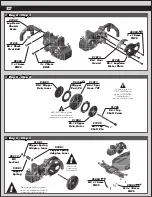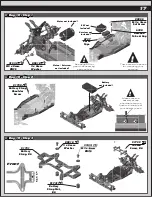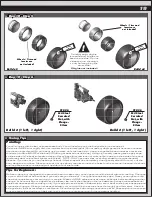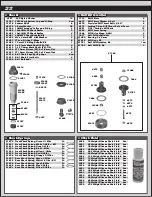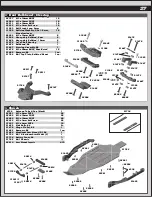
20
:: Tuning Tips (cont.)
Rear Camber:
Camber describes the angle at which the tire and wheel rides when looked at from the back. Negative camber means
that the tire leans inward at the top. A good starting camber setting is -1°. Adding a small amount of positive camber,
where the top of the tire is leaning out, will tend to improve straight-line acceleration on loose tracks.
Optional #1719 camber gauge can be used to more accurately set camber.
Slipper Clutch:
The assembly instructions give you a base setting for your clutch. Turn the nut on the shaft so that the end of the top
shaft is even with the outside of the nut. At the track, tighten or loosen the nut in 1/8 turn increments until you hear
a faint slipping sound for 1-2 feet on takeoffs. Another popular way to set the clutch is to hold both rear tires firmly in
place and apply short bursts of throttle. If the clutch is properly set, the front tires should lift slightly up off the surface.
Front Camber:
Camber describes the angle at which the tire and wheel rides when
looked at from the front. Negative camber means that the tire leans
inward at the top. A good starting camber setting is -1°. Positive camber,
where the top of the tire is leaning out, is not recommended.
Optional #1719 camber gauge can be used to more accurately set camber.
*Testing camber
with camber gauge
!
Gear Box Type:
Selecting the correct gear box is dependent on the type of track it will be used on. The optional 4 gear stand-up gear
box is for the lowest grip conditions. This gear box moves the weight towards the rear of the car and also uses the
rotation of the motor to transfer weight to the rear while on-power. The 3 gear stand-up gear box also moves the
weight towards the rear of the car, but in this configuration, the motor’s rotation helps with on-power steering.
The lay-down gear box is used on high grip conditions when on-power steering and stability are most important.
This gear box will change directions the quickest and generate the most steering. Layback is used for most indoor clay
track conditions.
Caster:
Caster describes the angle of the caster block as it leans toward the rear of the vehicle. Positive caster means the
kingpin leans rearward at the top. The kit includes three inserts to adjust caster angle at the caster block, 0
°
, 2.5
°
, and
+5
°
. The total caster angle is the sum of the kick-up angle and the caster block angle. Standard total caster angle for
the B6 is 30
°
, with 25
°
kick-up and +5
°
caster block angle.
For less entry steering and more exit steering, try 0
°
caster block angle.
Diff Height Adjustment:
The diff height adjustment is a good way to tune the car for grip level. On high grip with low ride heights, a higher diff
height will be a good option. On lower grip with higher ride heights, a lower diff height will be better.
Motor Gearing:
Proper motor gearing will result in maximum performance and run time while reducing the chance of overheating and
premature motor failure. The gear ratio chart lists recommended
starting gear ratios
for the most widely used
motor types. Gear ratios will vary depending upon motor brand, wind, and electronic speed control. Consult your
motor and electronic speed control manufacturers for more information.
Team Associated is not responsible for motor damage due to improper gearing.
Set The Gear Mesh:
You should be able to rock the spur gear back and forth in the teeth of the pinion gear without making the pinion gear
move. If the spur gear mesh is tight, then loosen the #31532 screws and move the motor away, then try again.
A gear mesh that is too tight or too loose will reduce power and damage the gear teeth.
29
27
24
23
22
21
20
Pinion
72
75
78
78
78
78
78
Spur
6.45:1
7.22:1
8.45:1
8.82:1
9.22:1
9.65:1
10.14:1
Final Drive Ratio
17.5 Reedy S-Plus Brushless
13.5 Reedy S-Plus Brushless
10.5 Reedy 540-M3 Brushless
9.5 Reedy 540-M3 Brushless
8.5 Reedy 540-M3 Brushless
7.5 Reedy 540-M3 Brushless
6.5 Reedy 540-M3 Brushless
Motor
B6 Gear Ratio Chart (Internal Gear Ratio 2.60:1)







